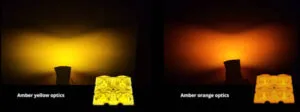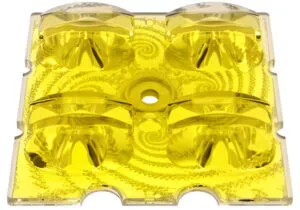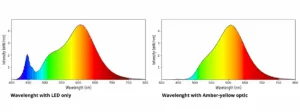
There are two tints: amber-yellow and amber-orange, and they are found in its Avika range.
“Blue wavelengths are known to disturb the natural behaviours of nocturnal and crepuscular species. Emit wavelengths above 560nm – amber, orange and red – to limit disturbances to animals,” said the company. “Our Amber-yellow lenses are developed to recreate the warm glow of traditional sodium lamps while being as energy-efficient as possible and environmentally friendly. Our Amber-orange lenses are ideal for architectural lighting in old cities and historical sites and areas requiring wildlife friendly lighting.”
It added that well focussed LED fixtures also reduce sky-glow and some habitat intrusion by directing light only downward.
 The amber-yellow tint lenses (left and graph below) converts 4,000K LEDs to 3,000K with less than 1.25% of light emitted at 500nm “transmitting wavelength that is sea turtle friendly”, said Gaggione. CRI is 68 and light output ratio (LOR) is 85%.
The amber-yellow tint lenses (left and graph below) converts 4,000K LEDs to 3,000K with less than 1.25% of light emitted at 500nm “transmitting wavelength that is sea turtle friendly”, said Gaggione. CRI is 68 and light output ratio (LOR) is 85%.
The amber-orange tint converts 3,000K LEDs to <1,900K, transmitting 85% of light between 560 and 700nm, but less than 0.5% of <500nm blue light “ideal for nocturnal animals and insects having specialised vision adapted to low-light conditions such as bats and owls”, said the company. CRI is 62 and LOR is 72%.
Both tints come in a two basic forms: for a 2 x 2 array of LEDs and an 8 x 1 array.
 Avika 2X2 is for mid and high-power domeless LEDs with a 5 x 5mm light emitting surface, or a domed 2mm2 emitters – and optimised for 3535 and 5050 packages
Avika 2X2 is for mid and high-power domeless LEDs with a 5 x 5mm light emitting surface, or a domed 2mm2 emitters – and optimised for 3535 and 5050 packages
Avika 8X1 is for high-power domed emitters up to 3.5 x 3.5mm, optimised for 3030 and 3535 packages.
A number of beam patterns are available for both
 Operating temperature for the standard PMMA (acrylic) lenses is -40 to +80°C, while higher temperature polycarbonate versions are available on special order.
Operating temperature for the standard PMMA (acrylic) lenses is -40 to +80°C, while higher temperature polycarbonate versions are available on special order.
Why not use warmer white LEDs?
“Maintaining aesthetic can be challenging due to the inefficiency of LEDs at 1,800K to 2,200K CCT, and the LEDs available in the market are often either too yellow or too white compared to conventional sodium lamps with yellow-orange hue,” said Gaggione
These lenses are designed and manufactured in France.
Gaggione web pages:
amber yellow
amber orange
